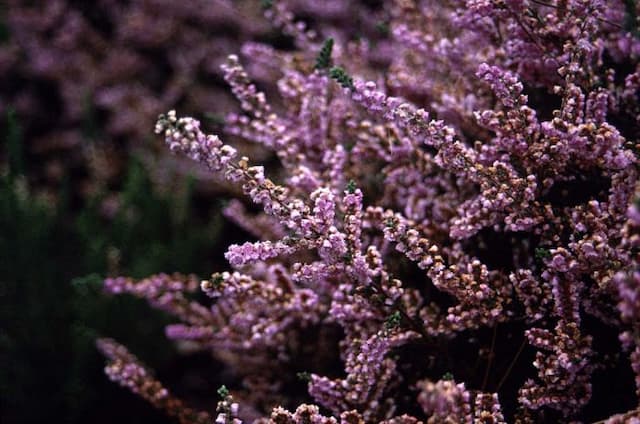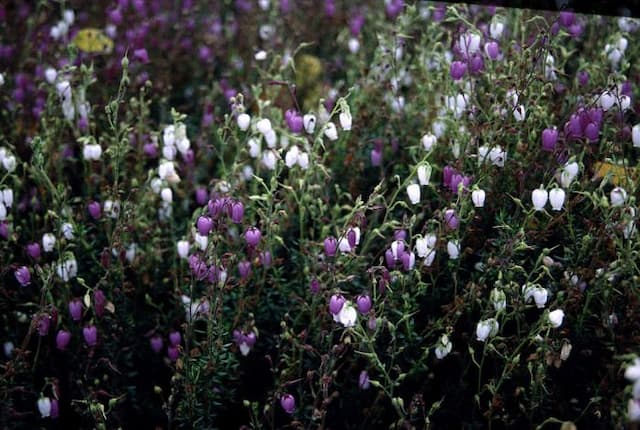Heather Calluna vulgaris 'Tricolorifolia'

ABOUT
Calluna vulgaris 'Tricolorifolia', commonly known as heather, is a small, evergreen shrub renowned for its distinctive foliage and flowers. The 'Tricolorifolia' cultivar stands out for the beautiful variation in its leaf colors. Throughout the year, the leaves present a unique tricolored pattern. The small, scale-like foliage appears in shades of green, yellow, and red, with the colors often appearing more vibrant when new growth emerges in the warmer seasons. The plant is also adorned with small, bell-shaped flowers that cluster along the upright stems, and tend to bloom from late summer into fall. The flowers are typically mauve to purple in color, making a striking contrast with the tricolored leaves. This shrubby plant has a bushy form with numerous branches that create a dense, mat-like appearance. Heather is highly valued for its long-lasting blooms and its ability to provide vibrant color to gardens even when other plants have finished their flowering season. It is a popular choice for rock gardens, borders, and as ground cover, thanks to its colorful foliage and attractive flowers.
About this plant
 Names
NamesFamily
Ericaceae
Synonyms
Heather, Scottish Heather, Ling
Common names
Calluna vulgaris 'Tricolorifolia'.
 Toxicity
ToxicityTo humans
Heather is not commonly known to be toxic to humans. There are no significant reports of poisoning or adverse health effects from ingesting this plant. As with any non-food plant, individual allergies or sensitivities could cause mild stomach upset or discomfort if ingested, but heather is generally considered safe.
To pets
Heather is also not commonly known to be toxic to pets. It is not listed as a toxic plant to cats, dogs, or other domestic animals by major pet poison helplines or organizations. However, as with any plant material, ingestion could potentially cause mild gastrointestinal upset for some animals due to individual sensitivities or if consumed in large quantities.
 Characteristics
CharacteristicsLife cycle
Perennials
Foliage type
Evergreen
Color of leaves
Mixed
Flower color
Varies
Height
1-2 feet (30-60 cm)
Spread
1-2 feet (30-60 cm)
Plant type
Shrub
Hardiness zones
4-8
Native area
Europe
Benefits
 General Benefits
General Benefits- Aesthetic Appeal: Adds vibrant color and texture to gardens with its tri-colored leaves and pink flowers.
- Drought Tolerance: Once established, can survive with minimal watering, making it suitable for xeriscaping.
- Low Maintenance: Requires minimal care beyond occasional pruning to maintain shape and encourage new growth.
- Wildlife Attraction: Attracts bees, butterflies, and other pollinators, supporting local ecosystems.
- Soil Erosion Control: Helps to prevent soil erosion with its dense, mat-forming growth habit.
- Hardy Nature: Can withstand harsh conditions including frost, making it ideal for cooler climates.
- Seasonal Interest: Offers year-round interest with evergreen foliage and seasonal blooms.
- Versatile Landscaping: Can be used for ground cover, rock gardens, borders, and containers.
 Medical Properties
Medical Properties- Anti-inflammatory: Calluna vulgaris, commonly known as Heather, is traditionally used for its anti-inflammatory properties.
- Diuretic: Heather is sometimes used for its diuretic effects, helping with urinary tract issues.
- Antiseptic: The plant has been used for its antiseptic properties, particularly in urinary and kidney ailments.
- Mild Sedative: Heather has a history of use as a mild sedative, particularly in folk medicine.
- Antirheumatic: It has been suggested to have antirheumatic effects, possibly helpful in managing symptoms of rheumatism.
 Air-purifying Qualities
Air-purifying QualitiesThis plant is not specifically known for air purifying qualities.
 Other Uses
Other Uses- The Heather plant's fibrous stems can be used in the crafting of small brooms, often referred to as "besoms," which are traditionally associated with cottage gardens and rustic households.
- Heather is sometimes used in the brewing of heather ale, a traditional Scottish beverage, offering a distinctive floral note to the beer.
- The plant has been used for dyeing wool and other fabrics, where it can provide a range of colors from yellow to green, depending on the mordant used.
- Heather twigs and foliage can be incorporated into thatched roofs, particularly in rural areas of Scotland and England, providing an additional layer of insulation and waterproofing.
- While not as common, heather can be used in the production of jewelry, where the wood is turned into beads or incorporated as part of decorative pieces.
- Calluna vulgaris can be placed in sachets along with other herbs to create natural moth repellents for wardrobes and drawers.
- In the art of bonsai, heather is occasionally cultivated for its small leaves and the potential to create a miniature landscape that mirrors the natural Scottish moors.
- Heather honey, made from bees that predominantly feed on heather nectar, is a unique and flavorful product distinct from other types of honey.
- In some traditional practices, heather was used as a bedding material for livestock, particularly in Scotland, where it provided warmth and comfort.
- Garden designers sometimes use dried heather in creating everlasting flower arrangements, as the plant retains its color well after drying.
Interesting Facts
 Feng Shui
Feng ShuiHeather is not used in Feng Shui practice.
 Zodiac Sign Compitability
Zodiac Sign CompitabilityHeather is not used in astrology practice.
 Plant Symbolism
Plant Symbolism- Protection: Calluna vulgaris, commonly known as Heather, is often associated with protective qualities, perhaps stemming from its hardy nature and ability to thrive in challenging environments.
- Good Luck: Heather is traditionally considered a lucky charm, especially in Scottish lore, where it is thought to bring good fortune to those who keep it.
- Admiration: The small, delicate flowers of Heather are symbolic of admiration and the beauty found in simplicity.
- Solitude: Due to its preference for growing in barren and open spaces, Heather can symbolize a love for solitude and the enjoyment of one's own company.
- New Beginnings: Heather blooms in the late summer, a time often associated with new starts and the beginning of the harvest season, thus representing new beginnings.
 Water
WaterHeather, or Calluna vulgaris 'Tricolorifolia', prefers evenly moist but well-drained soil. It should be watered regularly, especially during prolonged dry spells. Typically, the plant may need watering once or twice a week, depending on weather conditions. Each watering session should provide about 1 gallon of water, allowing moisture to reach deep into the root system. Adjustments in watering must be made during hotter, dryer periods when water may be required more frequently, and during cooler, wetter months when less watering is needed.
 Light
LightHeather thrives best in full sun to partial shade. It should be planted in a spot where it receives at least six hours of sunlight per day. Too much shade can result in sparse foliage and poor flowering. The ideal lighting condition is a combination of morning sun and afternoon shade, especially in regions with very hot summers.
 Temperature
TemperatureHeather is hardy and can tolerate a wide range of temperatures, from around 20°F in the winter to 90°F in the summer. Ideally, it thrives best in moderate temperatures, between 60°F and 70°F. It can withstand occasional cold snaps, but prolonged exposure to temperatures below 20°F may damage the plant.
 Pruning
PruningPruning Heather helps promote vigorous growth and maintains an attractive shape. Prune immediately after flowering, typically in late spring, by trimming off spent flowers and lightly shaping the plant. Pruning too late can reduce the following year's blooms, so it’s important to prune at the right time annually.
 Cleaning
CleaningAs needed
 Soil
SoilThe best soil mix for Heather 'Tricolorifolia', which is the most common name for Calluna vulgaris 'Tricolorifolia', should be well-draining and acidic with a pH range of 4.5 to 6.0. A blend of peat moss, sand, and pine bark or needles provides the desired acidity and drainage. Regularly check pH to maintain optimal soil conditions for health and vigor.
 Repotting
RepottingHeather 'Tricolorifolia' should be repotted every 2 to 3 years, or when it’s clear that the plant has outgrown its current container. This is less frequently than many other potted plants due to its preference for snug conditions that can support its compact root system.
 Humidity & Misting
Humidity & MistingFor Heather 'Tricolorifolia', moderate humidity levels are suitable. It doesn't require high humidity but shouldn't be placed in extremely dry environments, aiming for 40-60% relative humidity to maintain healthy growth.
 Suitable locations
Suitable locationsIndoor
Provide bright light and acidic soil for indoor Heather 'Tricolorifolia'.
Outdoor
Plant in well-draining, acidic soil; full sun or partial shade.
Hardiness zone
4-8 USDA
 Life cycle
Life cycleHeather 'Tricolorifolia' (Calluna vulgaris 'Tricolorifolia'), like other heathers, starts its life cycle with seed germination, which occurs in warm, moist soil conditions, typically in spring or autumn. After germination, the seedling grows into a juvenile plant, establishing a root system and a small number of shoots. As it matures, it enters the vegetative stage, producing a dense mass of colorful leaves and woody stems. This perennial shrub reaches the flowering stage in late summer to autumn, where it produces small, bell-shaped flowers that attract bees and other pollinators. After pollination, seeds are set and dispersed to begin a new generation. Heather 'Tricolorifolia' can survive for many years, with some individuals living for decades, during which it may undergo periods of vegetative growth and dormancy according to the seasons.
 Propogation
PropogationPropogation time
Spring-Early Summer
The most popular method of propagating Heather, including the Calluna vulgaris 'Tricolorifolia', is through semi-hardwood cuttings. This process typically takes place in late summer to early fall. To propagate, one should select a healthy stem, cut a 3 to 5 inch (about 7.5 to 12.5 cm) length of semi-hardwood, strip the lower foliage, and dip the cut end into a rooting hormone. This cutting is then placed in a well-draining potting mix, ensuring that the soil remains moist but not waterlogged. The environment should be kept humid, often by covering the pot with a plastic bag or placing it in a propagator. Root development may take several weeks, after which the new plant can be hardened off and eventually planted out.









